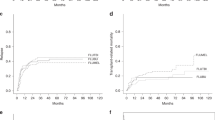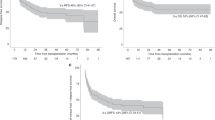Summary:
Allogeneic stem cell transplantation (allo-SCT) after a reduced-intensity conditioning (RIC) protocol is associated with decreased short-term toxicity. This suggests that the procedure could be performed on an outpatient basis. We analysed the incidence and risk factors of grade ⩾2 conditioning-related toxicities (CRTs) as a hallmark for hospital admission, in 41 consecutive patients allografted from an HLA identical sibling after RIC. The RIC regimen consisted of fludarabine plus melphalan for lymphoid malignancies, and fludarabine plus busulphan for myeloid malignancies. In all, 11 patients (27%) did not experience any toxicity. The more frequent CRTs observed were neutropenic fever and gastrointestinal toxicity. The median duration of hospitalisation was 27 (range, 17–50) days. If allo-SCT had been planned as an outpatient procedure and admission indicated only in the case of ⩾2 CRTs, the inpatient period would have decreased to 9 (range, 0–33) days (P<0.001). No risk factors for CRTs were identified. Allo-SCT after an RIC regimen is a well-tolerated procedure. Our results warrant a prospective pilot trial of nonmyeloablative allo-SCT performed in the outpatient setting.
This is a preview of subscription content, access via your institution
Access options
Subscribe to this journal
Receive 12 print issues and online access
$259.00 per year
only $21.58 per issue
Buy this article
- Purchase on Springer Link
- Instant access to full article PDF
Prices may be subject to local taxes which are calculated during checkout

Similar content being viewed by others
References
Barret J, Childs R . Non-myeloablative stem cell transplants. Br J Haematol 2000; 111: 6–17.
Carella AM, Giralt S, Slavin S . Low intensity regimens with allogeneic hematopoietic stem cell transplantation as treatment of hematologic neoplasia. Haematologica 2000; 85: 304–313.
Champlin R, Khouri L, Komblau S et al. Reinventing bone marrow transplantation: reducing toxicity using nonmyeloablative preparative regimens and induction of graft-versus-malignancy. Curr Opin Oncol 1999; 11: 87–95.
McSweeney PA, Niederwieser D, Shizuru JA et al. Hematopoietic cell transplantation in older patients with hematologic malignancies: replacing high-dose cytotoxic therapy with graft-versus-tumour effects. Blood 2001; 97: 3390–4000.
Weissinger F, Sandmaier BM, Maloney DG et al. Decreased transfusion requirements for patients receiving nonmyelo-ablative compared with conventional peripheral blood stem cell transplants from HLA-identical siblings. Blood 2001; 98: 3584–3588.
Miler AB, Hoogstraten B, Syaquet M, Winkler A . Reporting results of cancer treatment. Cancer 1981; 47: 207–214.
Giralt S, Estey E, Albitar M et al. Engraftment of allogeneic hematopoietic progenitor cells with purine analog containing chemotherapy: harnessing graft-versus-leukemia without myeloablative therapy. Blood 1997; 89: 12–20.
Khouri IF, Keating M, Korbling M et al. Transplant-lite: induction of graft-versus-malignancy using a fludarabine-based nonablative chemotherapy and allogeneic blood progenitor transplantation as treatment for lymphoid malignancy. J Clin Oncol 1998; 8: 2817–2824.
Schetelig J, Kröger N, Held TK et al. Allogeneic transplantation after reduced conditioning in high risk patients is complicated by a high incidence of acute and chronic graft-versus-host disease. Haematologica 2002; 87: 299–305.
Slavin S, Nagler A, Naparstek E et al. Nonmyeloablative stem cell transplantation and cell therapy as an alternative to conventional bone marrow transplantation with lethal cyto-reduction for the treatment of malignant and non-malignant hematologic diseases. Blood 1998; 91: 756–763.
Acknowledgements
We thank Schering Plough, Schering España, Merck Sharp and Dohme and Roche for their technical support.
Author information
Authors and Affiliations
Corresponding author
Rights and permissions
About this article
Cite this article
Subirà, M., Sureda, A., Ancín, I. et al. Allogeneic stem cell transplantation with reduced-intensity conditioning is potentially feasible as an outpatient procedure. Bone Marrow Transplant 32, 869–872 (2003). https://doi.org/10.1038/sj.bmt.1704254
Received:
Accepted:
Published:
Issue Date:
DOI: https://doi.org/10.1038/sj.bmt.1704254
Keywords
This article is cited by
-
Optimization of health-care organization and perceived improvement of patient comfort by switching from intra-venous BU four-times-daily infusions to a once-daily administration scheme in adult hematopoietic stem cell recipients
Bone Marrow Transplantation (2014)
-
Outpatient myeloablative allo-SCT: a comprehensive approach yields decreased hospital utilization and low TRM
Bone Marrow Transplantation (2010)
-
Comparable engraftment and chimerism kinetics using oral and intravenous fludarabine as part of a reduced intensity conditioning regimen
Bone Marrow Transplantation (2008)
-
Outpatient allografting using non-myeloablative conditioning: the Mexican experience
Bone Marrow Transplantation (2007)



